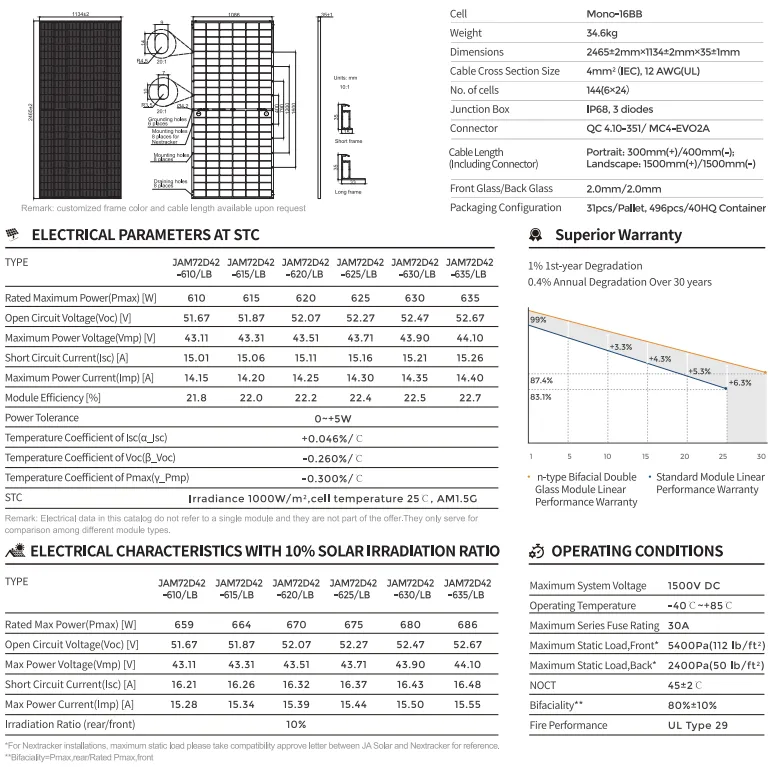photovoltaic cell
Photovoltaic Cells Harnessing the Power of the Sun
In an era where sustainable energy solutions have become paramount, photovoltaic (PV) cells have emerged as one of the most promising technologies to harness solar energy. These devices, often referred to as solar cells, convert sunlight directly into electricity through the photovoltaic effect. This article delves into the workings, benefits, and future prospects of photovoltaic cells.
Understanding Photovoltaic Cells
At the core of a photovoltaic cell is a semiconductor material, most commonly silicon. When photons from sunlight strike the surface of the silicon, they transfer their energy to electrons within the material. This energy enables electrons to break free from their atomic bonds, creating electron-hole pairs. The structure of the photovoltaic cell is designed to create an electric field that pushes these free electrons toward the front of the cell, generating a flow of electricity.
Photovoltaic cells come in various types, including monocrystalline, polycrystalline, and thin-film cells. Monocrystalline cells, made from a single crystal structure, are renowned for their efficiency and longevity, albeit at a higher cost. Polycrystalline cells, made from multiple silicon crystals, are less expensive and have a slightly lower efficiency. Thin-film cells, made from a variety of materials, are lightweight and flexible, making them suitable for unconventional applications, albeit with lower efficiency levels.
Advantages of Photovoltaic Technology
The benefits of photovoltaic cells extend far beyond their ability to generate electricity. Firstly, they are a clean and renewable source of energy. Unlike fossil fuels, PV cells produce no emissions during operation, contributing to a significant reduction in greenhouse gases. This aligns perfectly with global efforts to combat climate change and transition to sustainable energy systems.
Furthermore, photovoltaic cells offer energy independence. As solar energy is abundant and widely available, households and businesses can produce their own electricity, reducing reliance on centralized power grids. This local generation of electricity can lead to lower energy bills and increased resilience against energy price volatility.
photovoltaic cell

Another significant advantage is the scalability of solar energy systems. Photovoltaic technology can be implemented at various scales, from small residential installations to large utility-scale solar farms. This versatility allows for adaptation based on specific energy needs and available spaces, making solar energy accessible to a diverse range of users.
Challenges and Innovations
Despite their many advantages, photovoltaic cells are not without challenges. One of the primary obstacles is the efficiency of solar cells, which, although improved over the years, can be affected by factors such as shading, orientation, and the angle of sunlight. Researchers and engineers continue to innovate in this field, working on tandem solar cells, which layer different semiconductor materials to maximize light absorption and improve efficiency.
Another challenge is the issue of energy storage. Solar energy generation is intermittent, as it is dependent on sunlight availability. To address this, advancements in battery technology are crucial. Energy storage systems, such as lithium-ion batteries, are being developed to store excess energy generated during sunny days for use during periods of low sunlight.
The Future of Photovoltaic Cells
The future of photovoltaic technology looks promising. As the demand for clean energy sources continues to grow, investments in solar technology are expected to rise. Governments and organizations worldwide are implementing policies to support renewable energy adoption, leading to decreased costs and increased efficiency in PV cell production.
Moreover, the integration of solar technology into building designs—known as building-integrated photovoltaics (BIPV)—is gaining traction. This innovation allows for the installation of solar panels in building materials, such as windows and facades, further enhancing the adoption of solar energy.
In conclusion, photovoltaic cells stand at the forefront of the renewable energy revolution. With their ability to transform sunlight into electricity sustainably, they offer a pathway toward a cleaner, more independent energy future. As technology continues to evolve, the role of photovoltaic cells in our energy landscape will only become more significant, shaping a more sustainable world for generations to come.
-
Understanding the Advantages of Solar String Inverters for Your Energy SystemNewsApr.29,2025
-
Choosing the Right PV Inverter: A Comprehensive GuideNewsApr.29,2025
-
The Future of Solar Power: Exploring Bifacial Solar PanelsNewsApr.29,2025
-
The Complete Guide to Solar Panels: Efficiency, Cost, And InstallationNewsApr.29,2025
-
The Best Options for Efficiency and Cost-EffectivenessNewsApr.29,2025
-
Harnessing the Power of Off-Grid Solar Inverters for Energy IndependenceNewsApr.29,2025







